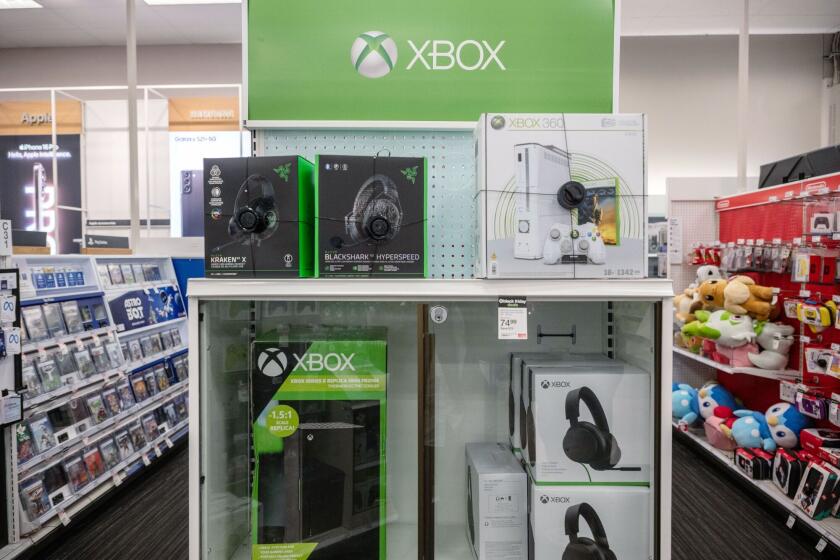Bidders for HomeFed Starting to Line Up
- Share via
SAN DIEGO — Prospective buyers won’t be allowed into HomeFed Bank’s San Diego headquarters to look at the books for another two months, but bidders are already lining up to make a run at the San Diego-based thrift when regulators sell it later this year.
The surplus of failed thrifts on the market notwithstanding, government officials say interest in HomeFed among potential buyers is high primarily because of two attributes: its 201-office branch network in California, including 62 in San Diego County, and a 20% share of the San Diego County deposit market.
Thirteen “serious” bidders have come forward so far, including American Savings, Great Western Bank, Home Savings, Golden West, First Nationwide Bank, Wells Fargo and Bank of America, well-placed sources say. The joint venture proposed this week by First Interstate Bank and Kohlberg Kravis Roberts & Co. may also consider HomeFed, industry sources said.
“I think everybody is dancing around the campfire on this one,” said Doug Stewart, principal at Secura Group, a financial consulting firm that advises purchasers and sellers on bank acquisitions.
The Office of Thrift Supervision announced that it would sell HomeFed after the savings and loan missed a March 31 deadline for raising new capital. After suffering losses of $1.04 billion in 1990 and 1991, the thrift, once an industry leader, has a capital deficit of $410 million.
OTS and Resolution Trust Corp. auditors will pore over HomeFed’s books for the next two months before potential buyers will get their chance to examine them. The bidding process will then last until late September, when a buyer is selected. Bids are expected for all or pieces of HomeFed, with the government trying to determine what will cost taxpayers the least.
Out-of-state interest in HomeFed is high. Half the bidders that have approached the government so far are financial institutions or investor groups based outside California, a well-placed source said. For those bidders, a HomeFed purchase would provide an immediate entree into the large, lucrative California market.
Still, most industry handicappers said this week that they expect the winning bid to come from a California bank or thrift seeking to consolidate or fill its statewide presence in an industry where economies of scale are increasingly critical.
“HomeFed’s branch system is highly attractive,” said an executive with one of the California-based prospective bidders. “They have good employees and a sales-oriented culture. With 20% of the San Diego deposit market, (acquiring HomeFed) is the last and best opportunity to build a major presence in San Diego overnight.”
David Hochstim, equity analyst at Bear, Stearns & Co. investment firm in New York, agreed: “HomeFed should be more valuable to someone already in San Diego so then they can combine branches and realize greater cost savings. If you have bigger branches, the more efficient you are and the better off you are.”
American Savings, with only nine of its 172 branches in San Diego, is considered a leading candidate to buy HomeFed. The thrift demonstrated an interest in making a San Diego acquisition when it submitted a bid in 1990 with Security Pacific Bank for Great American Bank’s California branches. But Wells Fargo Bank acquired the branches for $493 million.
Edward J. Carpenter, president of Carpenter & Co., an Irvine-based bank consulting firm, expects the winning bidder or bidders to be “California institutions because in-state bidders are far more familiar with the value and competitive nature of the state’s depository markets.”
“HomeFed has a particularly attractive branch delivery system in San Diego County that is comprised of very well-located, larger branch facilities that have been in their communities for many years, which have substantial base of loyal customers and which have higher than average level of deposits,” Carpenter said.
Said another bank industry source: “The bottom line is, HomeFed is able to take deposits and pay lower interest rates. They have a large base of passbook and NOW account deposits that are favorably priced.”
The thrift has suffered a loss of deposits in recent months because of bad publicity and downsizing. As of Dec. 31, statewide deposits stood at $10.2 billion, down from $13.7 billion a year earlier.
Bert Ely, an Alexandria, Va.-based banking consultant, said an acquirer will have to take care not to run afoul of antitrust laws, which would come into play if a HomeFed acquisition gave the buyer a market share of more than 30% of deposits in a given metropolitan area. Such problems arose recently in Bank of America’s purchase of Security Pacific, Ely said.
Only Wells Fargo and Bank of America appear to have deposit shares large enough in San Diego that a purchase of HomeFed would push them near or beyond 30%, according to year-old deposit figures.
More to Read
Inside the business of entertainment
The Wide Shot brings you news, analysis and insights on everything from streaming wars to production — and what it all means for the future.
You may occasionally receive promotional content from the Los Angeles Times.










